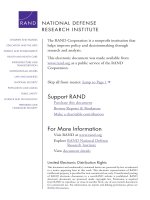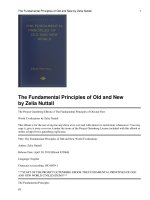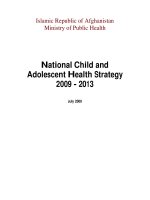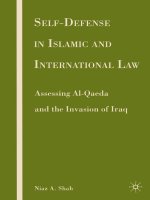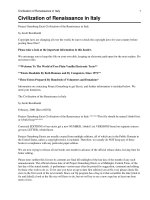Islamic Civilization
Bạn đang xem bản rút gọn của tài liệu. Xem và tải ngay bản đầy đủ của tài liệu tại đây (5.03 MB, 52 trang )
Islamic Civilization
Unity, Discipline, Organization
Arabia Before Muhammad
THE ARABS: During ancient times, the Arabs
inhabited much of the area from the Arabian
peninsula to the Euphrates River.
POLITICAL AND RELIGIOUS FEATURES:
The Arab world in the early 7th century had
no stable, large-scale political entities.
People belonged to close-knit clans, or
extended families, that formed tribes. Most
Arabs were pagans, but small minorities
were Jewish and Christian.
ECONOMIC
COMPONENTS:
Bedouins
Farmers
Traders
BEDOUINS (nomadic
pastoralists) provided
for their own needs
with:
Herds of sheep & goats
Small-scale trading in
towns
Regular raids on one
another and on
caravans.
FARMERS: Some
farmers worked the
land, but in many
areas soils were
too poor and rain
was too infrequent
to support
agriculture.
TRADERS: Cities supported traders who carried
luxury goods (spices, incense, perfumes) from
the Indian Ocean region and southern Arabia
along caravan routes to the cities of the eastern
Mediterranean. These traders formed the
economic and political elite of Arabia, and they
led the tribes.
Pre-Islamic Trade Routes
MECCA was the
most important
trade center in
Arabia. It was
dominated by the
powerful tribe of
the Quraysh
(KOOR-aysh).
THE KAABA: Mecca was
also the location of the
shrine known as the
Kaaba, founded according
to Arab tradition by
Abraham. For centuries
people from all over
Arabia had made
pilgrimages to Mecca to
visit the Kaaba, site of a
huge black meteorite.
Muhammad (570-632)
EARLY LIFE:
Muhammad was born
in 570 to a respectable
though not wealthy or
powerful clan of the
Quraysh tribe. His
father died before he
was born, his mother
shortly afterward,
leaving Muhammad
under the care of his
grandparents and
uncle.
CARAVAN TRADE: Like many young Meccans,
he entered the caravan trade. By the time he
was 30, he had a reputation for competence
and honesty, and so became financial adviser to
a wealthy Quraysh widow, Kahdija (KAH-deeah).
MARRIAGE: Although
older than Muhammad,
Khadija became his wife
in 596, and they had a
loving marriage until her
death. She bore him
three sons (all died in
childhood) and four girls
(all survived). Only one
daughter, Fatima, lived
after him.
THE REVELATIONS:
A man of spiritual
insight, Muhammad
received in 610 the first
of many revelations that
commanded him to
teach all people a new
faith that called for:
An unquestioned
belief in one God,
Allah
A deep commitment
to social justice
TEACHING IN MECCA:
Muhammad began
teaching in Mecca, but he
converted few people
outside his own circle.
Meccans feared that his
new faith might call into
question the legitimacy of
the shrines in Mecca and
jeopardize the traditional
pilgrimages to the Kaaba
with their accompanying
trade.
FLIGHT TO MEDINA:
At this point, citizens from
Medina, a smaller trading
community troubled by
dissension, asked
Muhammad to become their
leader. The journey from
Mecca to Medina is called
the Hijra (HEEZH-rah) and
the event was seen as so
important that 622 is the
year in which the Islamic
calendar begins.
UNITY: In Medina,
Muhammad gathered
around him a large
community of believers.
This group was to
become the foundation
of the Islamic state.
The substitution of faith
for blood ties was able
to unite rival Arab tribes
and bring about political
unity.
RETURN TO MECCA:
Although Muhammad
was fully in control in
Medina, Mecca
remained the focus of
his attention. Its
political and economic
importance were
critical to his desire to
convert all of Arabia.
ATTACKS ON MECCAN
CARAVANS: Therefore,
his followers began
attacking Meccan
caravans and battled with
the Meccans several
times in the 620s. In 630,
Muhammad and many of
his followers returned to
Mecca in triumph.
UNITED ARAB
WORLD: After making
local arrangements, he
returned to Medina
and set about winning
over the Bedouins of
the Arabian desert.
When Muhammad
died in 632, he had
converted most of the
Arab world.
SPREAD OF ISLAM:
Among the reasons for the
rapid and peaceful spread
of Islam was the simplicity
of its doctrine. Islam calls
for faith in only one God
worthy of worship.
MUHAMMAD’S TEACHING
People were asked to
surrender completely to
Allah, the one true God. The
surrender is known as alIslam.)
Those who surrendered
became Muslims and joined
the umma muslima – a new
kind of community.
AM
I R GLI P
GNI TS AF
I VI GS ML A
RE YARP
HTI AF
The Five Pillars of Islam
1. PROFESSION OF
FAITH (SHAHADAH):
Muslims bear witness to
the oneness of God by
reciting the creed "There
is no God but God and
Muhammad is the
Messenger of God." This
statement expresses a
Muslim's complete
acceptance of and total
commitment to Islam.

